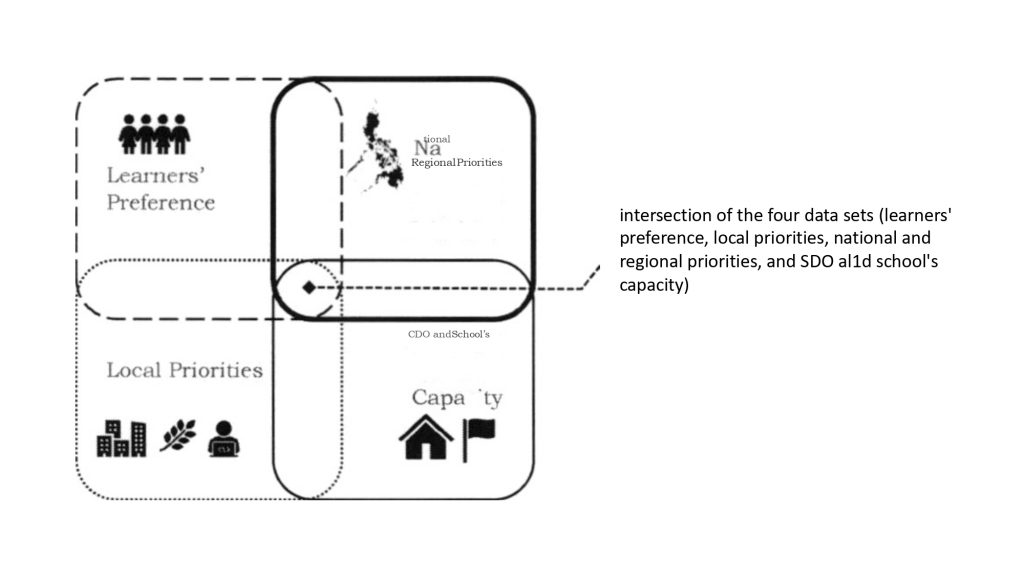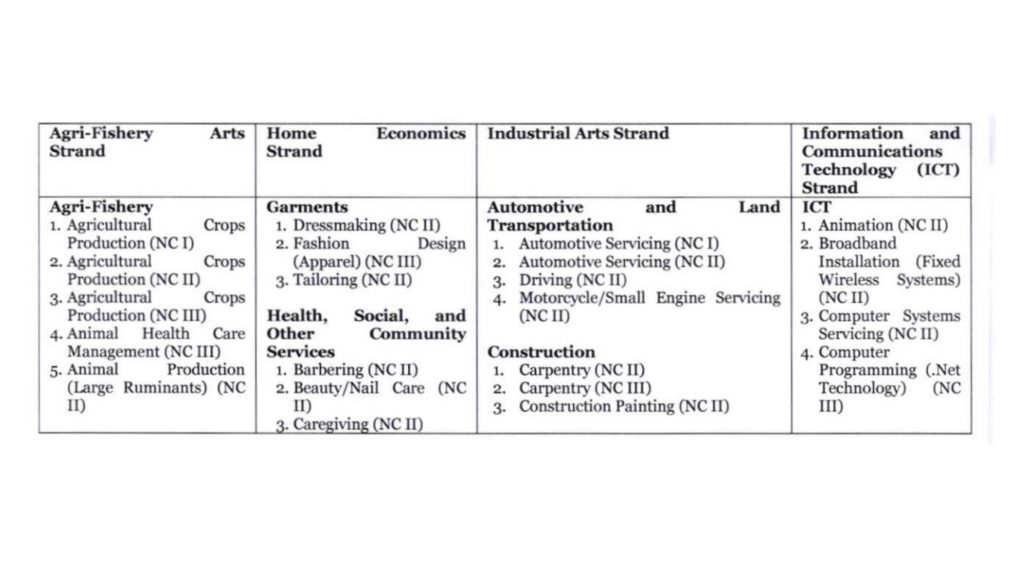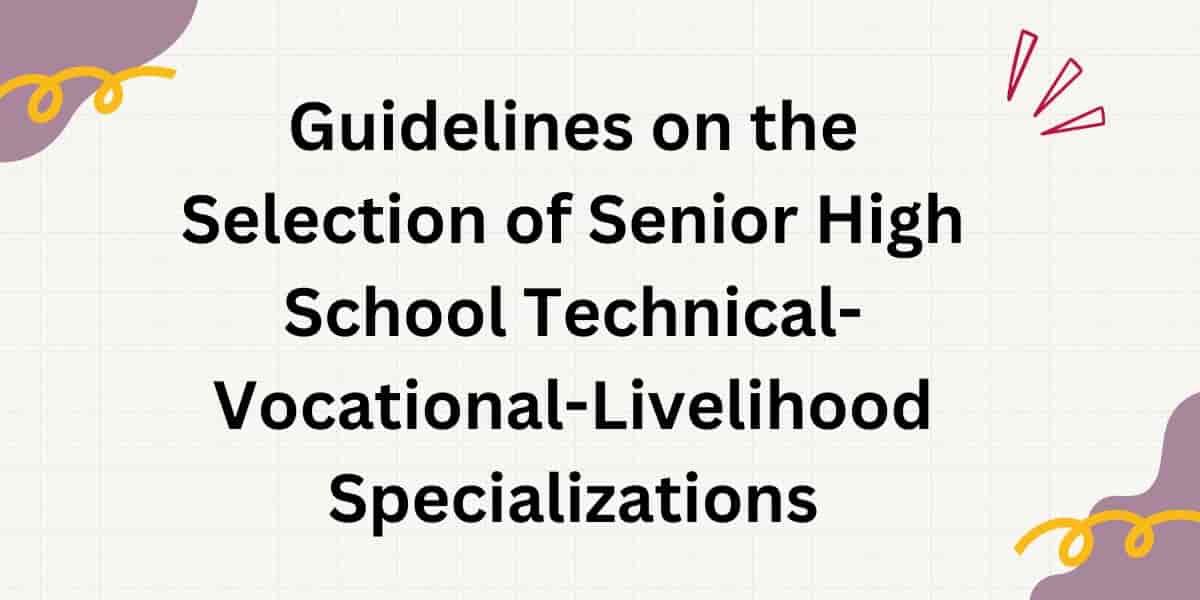The Department of Education (DepEd) issues the enclosed Guidelines on the Selection of Senior High School Technical-Vocational-Livelihood Specializations, which aims to institutionalize the steps to be undertaken by Schools Division Offices (SDOs) and Technical-Vocational-Livelihood (TVL) Senior High Schools (SHSs} to identify the TVL specializations to offer.
These guidelines shall be anchored on the principles of learner-centeredness, relevance, disaggregation, and localization. The process provided shall guide schools in organizing and analyzing data from learners, national, regional, and local development priority documents and data sources, and capacity of SDOs and schools to offer identified TVL specializations. Results from the analyses of these data will help SDOs and schools decide on which TVL specializations to offer.
Private schools and state universities and colleges that offer SHS TVL may adopt this policy.
The procedures outlined in these guidelines shall take effect starting School Year 2023 while the offering of the streamlined list of TVL specializations will be implemented from School Year 2024 onwards.
All DepEd Orders and other related issuances, rules and regulations, and provisions which are inconsistent with this Order are repealed, rescinded, or modified accordingly.
This Order shall take effect immediately upon its issuance. Its certified copies shall be registered with the Office of the National Administrative Register (ONAR) at the University of the Philippines Law Center (UP LC), UP Diliman, Quezon City.
For more information, please contact the Bureau of Curriculum Development, 3rd Floor, Bonifacio Building, Department of Education Central Office, DepEd Complex, Meralco Avenue, Pasig City through email at [email protected] or at telephone numbers 8632-7746 or 8635-9822.
Immediate dissemination and strict compliance of this Order is directed.
Guidelines on the Selection of Senior High School Technical-Vocational-Livelihood Specializations
I. Rationale
The country’s long-term development priority is encompassed in AmBisyon Natin 2040. AmBisyon Natin 2040 envisions the country as ‘a prosperous middle- class society where no one is poor, where people are smart and innovative, and where families thrive in vibrant, culturally diverse, and resilient communities.”
Building onto this vision, the Philippine Development Plan (PDP) elaborates on how Filipinos become ‘smart and innovative” by expanding their skill set to adapt to rapidly changing technology and work requirements. In PDP’s chapter on Accelerating Human Capital Development, a statement is included stating how lifelong learning will also ‘contribute to the development and growth of agriculture, industry, and services in the country.”
The National Technical Education and Skills Development Plan (NTESDP) also builds on AmBisyon Natin 2040, specifying the country’s medium-term goals in technical education skills and development. It identifies the priority sectors and subsectors and emphasizes the importance of the convergence of industrial technology and information technology.
Converting these medium-term goals to short-term and more nuanced goals are local development plans of cities and municipalities. These plans are the closest in context to Schools Division Offices (SDOs) and schools.
The Technical-Vocational-Livelihood (TVL} Track of the K to 12 Curriculum is in a unique position because its specializations have the potential to connect directly to the long-term, medium-term, and short-term national and local development priorities of the Philippines.
It is important to remember however that a key feature of the K to 12 curriculum is its emphasis on learner-centeredness. Therefore, learners’ preference must be taken into consideration vis-à-vis the local and national development priorities of the country.
Using the principles of learner-centeredness, relevance, disaggregation, and localization, this policy provides the guidelines which shall enable SHSs to decide on the best possible roster of specializations to offer by identifying the intersections between the national and local development priorities, learners’ preference and input, and SDOs’/schools’ capacity to offer specific TVL specializations.
This policy shall augment the absence of existing guidelines outlining the processes to undertake to ensure that TVL specializations offered by SHSs are in sync with learners’ preference, SDO and school capacity, and local and national development priorities.
II. Scope
These guidelines shall be anchored on the principles of learner-centeredness, relevance, disaggregation, and localization.
A process shall be provided which will enable schools to organize data from learners, the national, regional, and local development priority documents and data sources, and capacity of SDOs and schools to offer identified TVL specializations.
The provisions in this policy shall help Regional Offices (ROs), SDOs and schools decide on which TVL specializations to offer. The procedures outlined in the policy will be take effect starting School Year 2023 while the offering of the streamlined list of TVL specializations will be implemented from School Year 2024 onwards. Private schools, state universities and colleges who offer SHS TVL may adopt this policy. This policy shall only cover the current list of SHS TVL specializations.
III. Definition of terms
1. Disaggregation — Refers to subdivide or break priorities further into smaller In the context of this policy, disaggregation refers to the subdivision of national development plans/priorities based on local development plans. There are two kinds of disaggregation—disaggregation by sector and disaggregation by space.
2. Learner-centeredness – It refers to the priority allotted for learners’ preferred TVL
3. Local development plans — it contains the priorities at the province/city/municipal These are short-term in nature, with plans usually designed for three years of implementation.
4. Localization — It pertains to ensuring that priorities are in-line with the context at the province/city/municipal
5. National development plans — These contain the priorities identified at the national level and/or regional These are usually of a more generic nature and are for long-term or medium-term implementation.
6. Relevance — Refers to the alignment of technical skills development to local and national development
7. Sector – A sector is a collective term for a range of technical skills for a specific area or field (i.e., processed food and beverages, garments, electronics, and construction).
8. Senior High School (SHS) — Refers to the last two years of basic There are five tracks offered in SHS and these are the Academic Track, Arts and Design Track, Sports Track, and the Technical-Vocational- Livelihood Track.
9.Space —Used to refer to the immediate physical space near
10. Special Program for the Technical-Vocational-Livelihood {TVL} Track — refers to the different specializations and programs under/ related to TVL. Included in this category are the SHS Maritime Specialization, SHS Basic Conservation Program, and the Special Program in Technical-Vocational- Livelihood and Education (SPTVE) Program.
11. Technical-Vocational-Livelihood Track (TVLJ — The TVL Track is one of the four tracks offered in SH It has four strands which are the Agri- Fishery Arts (AFA) Strand, Home Economics (HE) Strand, Industrial Arts (IA) Strand, and the Information and Communications Technology (ICT) Strand.
IV. Policy Statement
DepEd issues this policy to institutionalize the steps to be undertaken by ROs, SDOs, and TVL SHSs to identify the TVL specializations to offer. Through this policy, SHSs shall offer SHS TVL specializations appropriate to learners’ preferences, local and national development plans, and school and SDO capacity. As a result, learners will be ready for any of the four exits of Senior High School—employment, entrepreneurship, middle level skills development, and higher education.
V. Procedure
Learner-centeredness
The principle of learner-centeredness is based on Section 5 of the Enhanced Basic Education Act of 2013 or Republic Act (RA) 10533. This section mandates that the K to 12 curriculum should be learner-centered. In this policy, learner preference is given importance through the learner preference survey distributed to learners and the gathering of schools’ enrolment data per specialization.
Relevance
The second principle, the principle of relevance, is centered around the alignment of the SHS TVL priorities to sectors that have high growth and increased prospects for employment. National and regional plans will be used as the basis to identify these relevant sectors.
Disaggregation
The third principle, disaggregation, is divided into two-disaggregation by sector and disaggregation by space. Disaggregation by sector provides a clearer picture of sectors and their sub-sectors. When taken in general, sectors may be seen to have low growth or may not have many opportunities for employment. However, subsectors within these groups may not all have the same behavior. Disaggregating sectors into their sub-sectors is a way to identify sub-sectors which are doing better than others in terms of growth and employment.
Spatial disaggregation, on the other hand, is based on geographic priorities and challenges. Both disaggregation by sector and space should be combined, which is what can be found in the Philippine Development Plan (PDP) 2017-2022.
Localization
Finally, the principle of localization highlights how information from the closest surroundings of schools act as the more immediate reference for SHS TVL. Province/municipality/city plans and data will be used to both disaggregate and localize national and regional plans. Learners’ preference and all data gathered at the local and national level will be studied vis-d-vis the SDO and schools’ capacity to offer identified specializations.
Table 1 presents the components needed for the planning and selection of TVL specializations to be offered by schools.
Table 1. Components for the Selection of TVL Specializations
| National and Regional Level | Provincial/City/ Municipality Level
|
Schools’ Level | Learners’ Level | |
| Applied
Principle |
Relevance;
Disaggregation by Sector |
Disaggregation by Sector and Space; Localization | Learner- centeredness | |
| Data
Source |
National Technical Education and Skills Development Regulations per sector)
Philippine Statistics Authority (PSA) Data (data on industries present in the region)
Department of Labor and Employment (DOLE) data (list of emerging jobs and industries) |
Philippine Development Plan
Community-Based Monitoring System (CBMS) data
Public Employment Service Office (PESO) data
Local government unit (LGU) priorities Schools Division Offices (SDOs) plans**
Cultural mapping data |
Enrolment data*
Schools’ internal assessments*
Available industries in the community |
Enrolment data*
Learners’ Preference Survey |
- including data from the Learner Information System (LIS)
- •including SHS mapping data
Other data sources may be included in the event of availability of other documents pertaining to local and national development plans.
The resulting intersections from the four data sets from each governance level shall be used by schools to decide on which TVL specializations should be offered. Figure 1 illustrates the kinds of data and the data intersections that this policy will help identify.

Figure 1. Intersections between learners’ preference, national, regional, and local priorities, and the SDO and school’s capacity
To identify the intersections, the following steps shall be followed by SHSs. A separate issuance will be provided to supplement this process.
Schools shall study the SHS TVL enrolment data per specialization (current SY and for the past three years). Grade 11 and 12 school enrolment data shall be recorded per specialization and sector. This information may be lifted from the US.
For easy reference, Table 2 lists the current TVL strand specializations organized according to sector.
Table 2. TVL Strand Specializations Organized per Sector*


1. Schools shall conduct a survey with Junior High School (JHS) learners, asking them to identify five preferred specializations per strand. If possible, the survey form may also be converted to an online form for easy distribution and submission, and faster consolidation and analysis of responses. Information gathered shall be treated according to the provisions in the Data Privacy Act.
For Steps 1 and 2, if the SHS is a stand-alone school, the school shall refer to the enrolment data and conduct the learner preference survey with students from their feeder JHSs.
Steps 1 and 2 ensure that the principle of learner-centeredness is upheld, as mandated in Section 5 of RA 10533. It is the first step, to indicate its importance over all the other principles in this policy.
2. Schools shall conduct an internal school assessment. Information on the number of available lecture rooms, laboratories, equipment, learning resources, faculty (with TM and NC), and work immersion sites may be lifted from the School-Based Management (SBM) data.
3. Schools shall study local development plans to identify the specializations which contribute to the growth of the local economy, generate the highest employment, and can accommodate learners for employment. Summarize the information gathered at the city/municipality/SDO level. Possible sources may include data from the Community-Based Monitoring System (CBMS), Public Employment Service Office (PESO), and the number of business permits released by the city/municipality, cultural mapping data, SHS mapping data, and other community-based/local initiatives.
4 Schools shall study the national priorities from national development plans. Based on the current list of SHS TVL specializations, identify the priority sectors listed in these plans (i.e., AmBisyon Natin 2040, National Technical Education Skills Development Plan, etc). These sectors are usually broad in nature, as it encompasses priorities at the national level. Because of this, it is possible that several SHS TVL specializations may be covered by one sector. For example, Tourism may cover Food and Beverage Services, Bartending, Commercial Cooking, etc.
For Steps 4 and 5, consultations and interviews may be conducted with national and local development groups as needed, to verify the gathered information.
5. Schools shall identify the specializations that fit all these five criteria:
a. Specialization is among those with the greatest number of enrollees
b. Specialization is among the Top 5 preferred specializations per strand, based on the ranking of specializations from the Learner Preference Survey
c. School has sufficient requirements to offer specialization
d. Specialization is in the local development plans/priorities
e.Specialization is in the national development plans/ priorities
Based on these criteria, schools shall list the specializations which they will continue to offer. Schools shall only choose the specializations which are common among the four data sets considered. Schools shall also justify offerings which will be continued despite lacking requirements.
Schools may also indicate new/unique specializations to offer based on their data gathering and analysis. They are then directed to follow the provisions listed in DepEd Order 51, s. 2015 (Guidelines on the Implementation of the SHS Program in Existing Public JHSs and Integrated Schools, Establishment of Stand-Alone Public High Schools, and Conversion of Existing Public Elementary and JHSs into Stand-Alone SHSs) and DepEd Order 76, s. 2016 (SHS School Manual of Operations Volume 1} as needed.
6. Schools shall then submit the summarized data to the SDO
7. The Curriculum and Instruction Division (CID) of the SDO through the Technology and Livelihood Education (TLE} Supervisor, shall verify information in the School’s Data Summary through ocular inspection and online/in-person correspondence with the school’s focal
8. Regional Offices shall release approval of TVL specializations, through the RO Curriculum and Learning Management Division (CLMD), signed by the Regional
9. The Central Office through the Bureau of Curriculum Development shall release an issuance further outlining the process to be undertaken for each step.
These procedures shall be followed every year. In summary, these are the information which shall be gathered by schools:
Table 3. Information to be Gathered by Schools and their Purpose
| Information | Purpose |
| Grades 11 and 12
Enrolment Data |
Provides information on the number of SHS students
enrolled per strand, sector, and specialization |
| Learner Preference Survey | Provides insight on learner’s preference in terms of the SHS TVL specializations they would like to enroll in |
| School’s Internal
Assessment |
Itemizes the existing laboratories, equipment, learning
resources, faculty, and work immersion venues per sector and specialization |
| Local and National
Development Information |
Shows the specializations which contribute to the
growth of the national and local economy, generate the highest employment, and can accommodate learners for employment |
| School’s Data Summary | Provides a space to summarize findings, list specialization which will be continued, and new specializations which will be proposed. |
Table 4 outlines the timeline and procedures that shall be followed.
Table 4. Timeline and Procedure
| Steps | Quarter | Tasks | Output |
| Step 1 | Quarters 3-
4 (current school year) |
1. Release of Learner Preference Survey to students
2. Collection of Learner Preference Survey |
1. Released Learner
Preference Survey 2. Collected Learner Preference Survey forms |
| Step 2 | Quarter 1 (succeeding school year) | 1.Collection of enrolment data
(Including the current school year} 2. Tallying and encoding of results of Learner Preference Survey |
1. Collected Grades
11 and l2 enrollment data 2. Tallied survey results 3. List of specializations preferred by learners |
| Step 3 | Quarter 2
(succeeding school year) |
1. Schools conduct internal assessment
2. Studying of local and national development plans (consultations and interviews conducted as needed) 3. Make the summary of data gathered 4. Schools submit list of specializations to SDO for approval and endorsement. |
1. Internal
assessment results 2. List of specializations relevant to the economy 3. Summary of all data gathered |
| Step 4 | Quarter 3
(succeeding school year) |
SDO submits list of specializations
to ROs for approval. |
Approved list of SHS
TVL specializations to offer |
VI. Monitoring and Evaluation
1. The Central Office through the Bureau of Curriculum Development and the Bureau of Learning Delivery shall provide technical assistance as needed through input on curriculum and list of specializations to be offered based on the TLE and TVL Curriculum Framework and the Rationalization of TLE and TVL specializations.
2. ROs, through the CLMD shall monitor compliance of SDOs to this policy. RO CLMD will also provide technical assistance during implementation.
3. SDOs through the CID and the TLE/TVL Supervisor, shall monitor compliance of SHS TVL schools to all procedures in this policy. They will utilize data at their disposal accurately.
4. Schools through the Principal, Registrar, and the SHS/TLE/TVL Focal Person shall monitor their enrolment, specializations they offer, compliance with required facilities, availability of resources, and other relevant data.
5. SDOs shall submit the summary of data gathered to the RO. ROs will consolidate reports and submit the summary to the BCD. These shall be done every end of the school year.
6. The DepEd Central Office, through the Bureau of Curriculum Development (BCD), shall validate the consolidated reports from the ROs and evaluate the implementation of the policy. BCD shall also conduct an outcome evaluation of this policy after its third-year implementation.
VII. References
Asian Development Bank. (unpublished). Draft National Framework for Senior High School Technical-Vocational-Livelihood Track Development.
Department of Education. (2019). DepEd Order No. 21, s. 2019. Policy Guidelines on the K to 12 Basic Education Program.
Department of Education. (2016}. Memo No. 76, s. 20 l6. Senior High School Manual of Operations.
Department of Education. (2015). DepEd Order 51, s. 2015. Guidelines on the Implementation of the Senior High School Program in Existing Public Junior High Schools and Integrated Schools, Establishment of Stand-Alone Public High Schools, and Conversion of Existing Public Elementary and JHSs into Stand-Alone Senior High Schools.
Department of Education. (2015). DepEd Order No. 40, s. 2015. Guidelines on K to 12 Partnerships.
Department of Education. (2013). K to 12 Technical-Vocational-Livelihood Curriculum Guides.
National Economic and Development Authority. (2016). AmBisyon Natin 2040: A Long-term Vision for the Philippines.
National Economic and Development Authority. (2017). Philippine Development Plan 201 7-2022.
Technical Education and Skills Development Authority. (2018). National Technical Education and Skills Development Plan 2018-202 2.
VIII. Effectivity/Transitory Provision
The procedures outlined in the policy shall take effect starting School Year 2022 while the offering of the streamlined list of TVL specializations will be implemented from School Year 2023 onwards. The policy shall be registered with the Office of the National Administrative Register at the University of the Philippines Law Center, UP Diliman, Quezon City. It shall be published in the official gazette or newspaper of general circulation.
All DepEd Orders and other related issuance s, rules, regulations, and provisions which are inconsistent with these guidelines are hereby repealed, rescinded, or modified accordingly.






